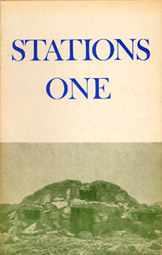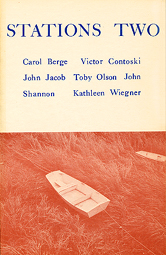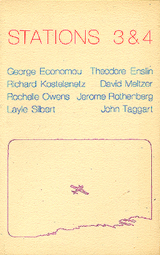As I worked on Freek I thought of other magazine strategies.
Some of my models, from earlier entities such as Little Review and
Rongwrong to more or less current productions from
Trobar to Grist to Buddhist Third Class Junk Mail
Oracle to Fuck You: A Magazine of the Arts to Catterpillar,
gave me ideas of things NOT to do as well as suggesting new
possibilities. Freek had also taught negative lessons.
By the time I began Stations, I had all sorts of ideas to pursue
with a new magazine. I articulated this in a long-winded
introduction to the first issue, and more succinctly in the editorial to the
second. The first issue has the following lines as a preface, before
my editorial:
Whatever you have to say, leave
the roots on
let them dangle. . .
and the dirt
just to make clear
where they came from
- Charles Olson
That was its essence. The editorial for the second issue stated what that
meant to me in less poetic terms, and more succinctly than I had done in
the first editorial, or would be likely to do now:
Writing comes from the writer's development, changes, new starts, false
starts; it comes from his or her changing awareness of self and
environment and not least from testing new ideas. Sometimes it comes as
a sudden burst; more often from years of meticulous attention and slow
growth. It usually does not come out full blown and finality is often
beyond the point. . .
So far I've tried to present new writing as clearly as possible in
magazine format by A, concentrating on half a dozen contributors per
issue; B, including a good, healthy amount of work from each;
C, paying special attention to sequential selections, works in
progress, selections that indicate a writer's development or recent
attempts at change; D, asking contributors to comment on their
work. Select bibliographies are also included; if you like what you
find here, you'll be able to find more.
The works in this issue of STATIONS are offered as stations on
the way, stages on a journey, not summations or final resting places.
The magazine itself is in transit; hopefully, new editorial approaches
will suggest themselves as things change, and the magazine will change
with them.
I had come to see the ideal magazine as more than the expedient which
earlier periodicals had been. The book was the proper place for work
that had come to a more stable resting place. I use the word "resting"
here in the sense of taking a break before going on to other stages.
Given the economics of production and the rapid growth of the national
poetry scene, a magazine could be more a progress report on the way to
the book stage. If, as Pound had put it, poetry was news that stayed
news, the kind of magazine I wanted to edit was news about the
mechanics of how poetry came to stay news.
This was essentially another means of triangulation. I intended to
publish a fair number of the writers who appeared in Stations
in book form, and to give readers another vantage point to view the
work of authors I published in book form if they came to the books
first. The contributors to each issue should not belong to a single
group or movement, but emphasize each other's uniqueness by contrast,
and, with luck, suggest forms of hybrid vigor that could result from
intersections of method and matter. As with earlier magazines, this
one gave the reader work by a number of people, and presumably
they'd find something interesting, even if they didn't find all the
entries of great value. Thus they would not feel cheated; and perhaps
they'd want to check out the books of some of the contributors, as
well as get progress reports and rough drafts of some of them while
they were still in the works.
I wanted to do whatever I could to build up a body of criticism
and interpretation by the authors themselves, freeing them from an
excessive dependence on critics who wrote nothing but crit, moving
criticism away from the strange ivory-tower disconnection it sometimes
seemed to lose itself in, and perhaps encouraging greater self-analysis
among the writers. This was a time of declarations
of independence, and I hoped to find some in the contributors' notes
sections. Of course, some contributors went through all sorts of
contortions not to sound like critics. The diversity of their responses,
even when the comments were simply more poems or belles-letteres
vagueries, seemed to present a healthy pluralism. This effort at
encouraging poets to act as their own explicators and critics proved
more important a year or so after I began it in Stations,
when Tom Montag began publishing Margins
Producing Stations One
The first two issues more or less edited themselves in conjunction with
my other publishing efforts and in relation to my discussions and
correspondences with the writers whose work went into the magazine.
Although the editorial process took care of itself, producing the
first and third volumes was anything but that. I began setting type on #1
at a time when Ed Wolkenheim's shop was in perhaps its most halcyon stage.
We had committed ourselves to the use of recycled and salvaged paper,
and had managed to scrounge equipment at minuscule prices, selling some
of it to other printers. We were at times so busy with commercial jobs
that I was able to hire a friend (a professional stenographer) to set
some of the type that would present the most proof reading problems.
The business brought in money, but it also got in the way of work.
In a period of two seasons, the golden age of the shop collapsed. In
one way, "collapse" was literally true: the ceiling of the first floor
fell, pulling most of the electric wiring with it. We drilled holes
through the floor to bring electric wires up from the basement, and
cleared work areas around the light table, the arc, the press, and a few
other essential areas, leaving the rest in cluttered and jagged shadows
that seemed reminiscent of photos of bombed cities. Ed's wife, Barbara,
became utterly disgusted with the business and wanted to get as far away
from it as possible. I talked Ed into continuing with the shop, though
his drinking accelerated to the point of becoming constant, even when he
got a part time job with another printer. Although Ed had profoundly wanted
to continue the business, he came to resent me for keeping it going, and he,
Barbara, and I each became antagonistic with the other two. Pat Wagner
continued working part time at the shop, and, just as important, mediated
between the three of us. Perhaps ironically, this came almost immediately
after Pat and I had made the first moves toward getting what would become
The Water Street Arts Center in the works, and we continued our practice of
scheming over lunch, figuring out ways of acquiring salvageable scrap paper
for close to nothing, and setting up booths from whence to sell books at
rallies, meetings, and other functions. This kept Pat's spirits and mine
up at a time when they could easily have faltered.
One of the diamonds-in-the-rough Ed and I had picked up was a process
camera. Its housing was a wreck, but its lens was in perfect condition.
As the personal situation deteriorated in the building, I hurriedly
finished setting the type so I could make the negs before everything
came undone. At this point, the basement, where we had installed the
camera, flooded. We had to figure out ways of keeping the wiring in
the basement elevated out of the water, but accessible through the
ground floor. This meant that the basement was without illumination or
other power except for the safe light and other gadgets in the
developing room and a set of wires hung from the ceiling to the
camera. Ed and Barbara hadn't changed the litter boxes for their cats
in months, and cat shit glided around the basement in flotillas.
I had a nasty case of the flu by the time I had finished setting the
type. However good the lens on the camera was, the housing was a
complete mess. The only thing I could do was to work out shims and other
devices to get decent negatives. This meant I had to spend several
weeks in the near total darkness of the flooded basement, inside the
camera frame, making one exasperating adjustment after another with
a flashlight tucked under my arm. This and other shop business took
as much as 14 hours a day. By the time I had the negs for Stations
One completed, the antagonism between Ed and me had reached such a point
that he wouldn't let me use the press. I initially went through the odd
process of hiring another printer to run part of the magazine in the
shop where I could no longer work myself. This situation proved nonviable,
and the printed parts of the magazine sat for several months.
Finally, Pat printed the last signatures with neither Ed nor I present -
initially without Barbara's approval, but finally with her blessing and
Ed's curse.
I had managed to move some of the equipment I had purchased out of this
shop and into the new shop I was setting up in my basement. The huge
Chandler and Price paper cutter we had bought for a song was nearly
untransportable, and certainly something I couldn't have fitted in my
own home even if I'd been able to move it. I thus had to wait
several more months before I could bind it. As a consolation, the
paper cutter I bought was a Triumph (same company that makes the cars
and motorcycles), and the only major piece of printing equipment I
bought new. Although I began the first issue of Stations in 1971,
and set the type on the copyright date in 1972, I didn't have bound
copies ready for sale until 1973.
Producing Stations Two
By the time I printed the second installment, things had evened out in my
own shop, and producing it was gratifying, with none of the nightmare
quality of the inaugural issue.
The cover design for number One included a photo of the remains of one
of the houses of a Viking colony in Greenland on the front, and an
Inuit tent on the back. I'd meant to suggest by this an attempt at meeting
by cultures from Europe and North America over the top of the world,
and outside the historically sanctioned meeting of hemispheres, with a
grim, though oblique, allusion to the continuing Vietnam war.
I used a photo of a boat in a salt marsh at low tide in Gloucester for the
front cover of Two. The back was more important personally. Without
attempting to keep the business going, Ed and I had reconciled our squabbles.
I used a photo he had taken of the Red Star Yeast factory as seen from
the freeway above what we then called "the Industrial Valley," since it
provided a cradle and base for many of Milwaukee's heavy industries.
Ed converted the photo into a mezzotint, and we both thought enough of
it to put prints of it up on our walls. I originally suggested using it
on the front, but talking over sketches of the cover with Ed, he decided
he'd rather see it on the back, in effect giving him the last word. If
the cover of One suggested meetings of peoples over an icy part of the
world, the cover of Two should suggest two dimensions of urban and
coastal ecology, a subject important to Ed and to me, and one which we had
spent endless hours discussing in the Speed Press days. As a kind of
celebration that only Ed and I could appreciate, I was able to use
Riverside Polysolve stock for Two. This was a recycled paper whose
manufacture addressed several environmental problems Ed and I had spent
a lot of time arguing about and speculating upon.
Producing Stations 3 & 4
Producing Stations Two may have been an idyllic interlude. Problems
with the next issue, which time turned into two issues, proved both literary
and to some extent technical. The first major
obstacle came from translations of poems by Octavio Paz. I had hoped
to include translations regularly in Stations, and had featured
a selection of contemporary Polish poets by Victor Contoski in Two. My
orientation toward pluralism was not limited to single schools or single
points of view, but sought to bring about greater confluences and
perspectives through transformations of language and the sharing of art. My
major interests were in Chinese and Spanish poetry, however - the latter
particularly so since I saw the Latinization of Anglo-America as taking place
more quickly than its Asianization. Roger Skrentny had spent several years
translating Paz. These translations seemed an ideal place to start with
translations from Latin American contemporaries. The translations had played
a key role in Roger's development as a poet, and one of the major roles
of translation has seemed to me to be the way it helps poets learn their
art. Unlike Neruda, Vallejo, Huidobro, etc. however, he was Mexican, from the
U.S.'s neighbor. Since he had spent considerable time in the U.S.,and
spoke immaculate English, he seemed someone Mexicans, Chicanos, and Anglos
could identify with. He had also done early work with indigenous sources
and formal properties. This endeared him to me, since I had worked
from some of the same sources. I began what turned out to be a long campaign
to try to gain his consent to the publication of the translations, pointing
out in various letters that no one would see these as definitive translations,
or as renderings that would compete with Elliot Weinberger's official
versions; I tried detailing what
I wanted to do as far as encouraging communication between cultures
and stimulating a literary and artistic syncretism that was in progress
and for which I had great hopes, pointing out that consent and
consecration were different things and I only wanted the former, not because
I needed it in the context of alternative publications of the time, but as
a basic gesture of cooperation among poetsn. At several points, I
asked people who knew Paz to write on my behalf. Nothing I could do, however,
brought him around. After over a year of trying, Roger became discouraged
with what he perceived as a rejection by Paz, and I had to try to prop
him up by assuring him that Paz must have had other motives, and that, in
any case, foreign language poetry should never have to rely on just one
translation. The discouragement, however, deepend for Roger, particularly
in conjunction with other rejections.
During the interminable period of trying to gain consent, I became more
involved with book publishing, and with Margins, particularly my
symposium series, which took on more of the initial functions of Stations.
Nonetheless, I was able to obtain "Face," a poem of David Meltzer's that
was essential to my reading of him, and the only poems by Rochelle Owens
I would be able to produce in print while I edited my symposium on her.
I also added several sequences of what Richard Kostelanetz called
"visual fictions" (though I saw them as correctives to the static nature
imposed on visual poetry by the Williams and Solt Concrete anthologies).
I also brought in selections from John Taggart and George Economou, both
of whom seemed on the verge of making radical changes in their work -
something I wanted to capture in progress in the magazine. Elsewhere
in the work in progress department, it seemed as though the notebooks
which Jerome Rothenberg worked on while compiling his anthology, A Big
Jewish Book, would appear as a book published by me, and possibly as
commentery in the anthology before I got the magazine out.
Although much of the editorial and production processes had gone serenely,
those that held up publication seemed like a weight pressing more heavily
on me. I printed part of the issue over a year before it came out. During
the final stages, I worked too fast, and was not satisfied with the results
of the finished book. Any number of people expressed initial dissatisfaction
with it during the first months after publication. Discouraged, and profoundly
engaged with other projects in the works, I decided to suspend publication
indefinitely during the following year. I didn't know then that I would
revive it for a very different sort of project a few years later. Nor did I
anticipate that however much people complained about 3 & 4, many of them
would complain more about its disappearance or that others would be
adamant about the value of the three volumes that appeared.
But aside from
discouragement and encouragement, it seemed I had explored all that I could
manage in the type of magazine I could produce in my own shop. Margins
was something different, and as much as I could contribute to it as Associate
Editor, I could not have published it myself.
3 & 4 got the best cover art of the series, two extremely delicate drawings
of airplanes by Jan Serr. I used an equally delicate and spindly type to go
with them. The reproductions presented here don't do Jan's drawings anything
like justice, though they were ideal for a small printing press.


